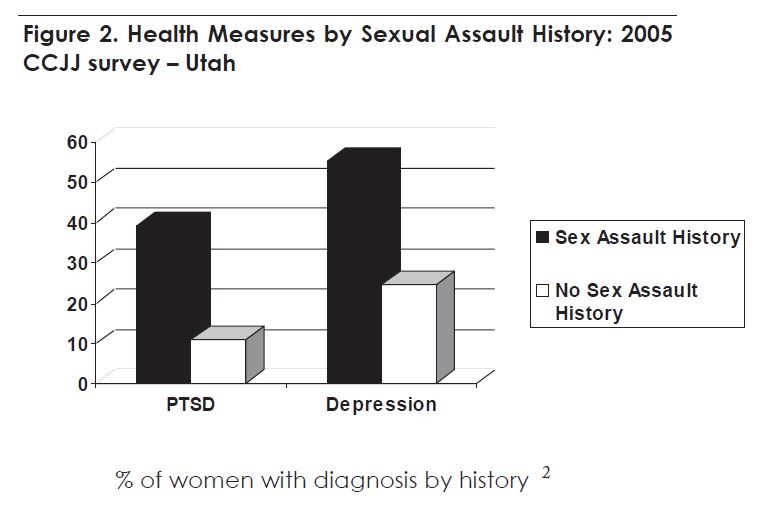Rape is the only violent crime in Utah with a rate that exceeds the national average. For 2005 the FBI Uniform Crime Reporting Program data shows a national rate for forcible rape of 31.7 per 100,000 inhabitants, while Utah specific data shows a rate of 37.3 per 100,000 inhabitants [1]. These data place Utah as 17th highest in the nation for forcible rape in 2005. This reported data does not distinguish between male and female nor age specific reports and relies on crimes reported to law enforcement agencies.
Legal definitions of crimes related to sexual violence vary from state to state, making accurate national comparisons difficult. For this report, rape is defined as forced sexual penetration. All other forced or non-consenting encounters are referred to as sexual violence or sexual assault. Child Rape and sexual assault are not specifically addressed in this report.
The CDC estimates that in 2002 only 39% of victims of rape and sexual violence reported the crime to law enforcement. This under reporting contributes to inaccuracies in estimates of the true magnitude of this crime. In 2005 the Utah Commission on Criminal and Juvenile Justice (CCJJ) produced a report “Rape in Utah – A Survey of Utah Women About Their Experience with Sexual Violence” [2]. This survey showed that only 9.8% of women in Utah who were assaulted reported the crime to law enforcement.
The 2005 Utah CCJJ report showed that 12.7% of respondents reported being raped in their lifetime. It also showed that in Utah “nearly 1 in 3 women will experience some form of sexual violence during their lives.” Additionally, there was no relationship found between race or income with regards to sexual victimization. This telephone survey of women 18 and above defined rape as forced oral sex, forced anal sex, object rape, sexual battery or attempts of any of these various sexual assaults, or forced to engage in sexual intercourse with a current or past husband, or forced into intercourse when they could not give consent (under the influence of drugs or alcohol, or drugged without their knowledge.) The results of this report supported accepted national statistics that 1 in 4 women will be victims of sexual violence in their lifetimes.
Rape and sexual violence have significant consequences on the health of the individuals who are victims of these crimes [3]. These consequences include multiple issues with long term consequences including physical (gynecological, sexually transmitted diseases, pregnancy, urological, gastrointestinal, headaches, back pain, chronic fatigue, etc), psychological (post-traumatic stress disorder or PTSD, suicide and suicide attempts, fear, anxiety, sleep disturbances, depression, etc.) socioeconomic (disability, work hours lost), social disturbances in relationships (isolation, less likely to be married), and changes in health behaviors (increased high risk sexual behavior, smoking, alcohol and drug use) [4,5]. The Utah CCJJ
report of 2005 showed that women who have been sexually victimized “scored negatively on several measures of health and mental health”, were “much more likely to meet the diagnostic criteria for Post Traumatic Stress Disorder” and were “more likely to rate their health as being poor.”
We have a number of resources for care and crisis intervention for victims of sexual violence in our state. A statewide crisis line 1-888-421-1100 is sponsored through the State Health Department. This line will link victims with crisis intervention and referrals closest to their community. Additionally, specialty trained Sexual Assault Nurse Examiners are available in 18 of our 29 counties to provide care and forensic evidence collection following report of sexual assault and rape.
To combat the crisis of crimes of sexual violence and reduce the impact of this violence on the health of women in our state we must focus on prevention. Although not all men are perpetrators, almost all perpetrators of sexual violence are men. The CCJJ survey again supported national data showing that 96.6% of respondents were attacked by a male. We must address prevention and social change beginning with the youngest children and continuing throughout the life span.
References
- http://www.fbi.gov/ucr/ucr.htm
- http://www.justice.utah.gov/Research/SexOffender/RapeInUtah.pdf
- http://www.cdc.gov/ncipc/factsheets/svfacts.htm
- Golding JM, Wilsnack SC, Cooper ML J Trauma Stress. 2002;15:187-197
- http://www.jahonline.org/article/PIIS1054139X04000990/abstract



